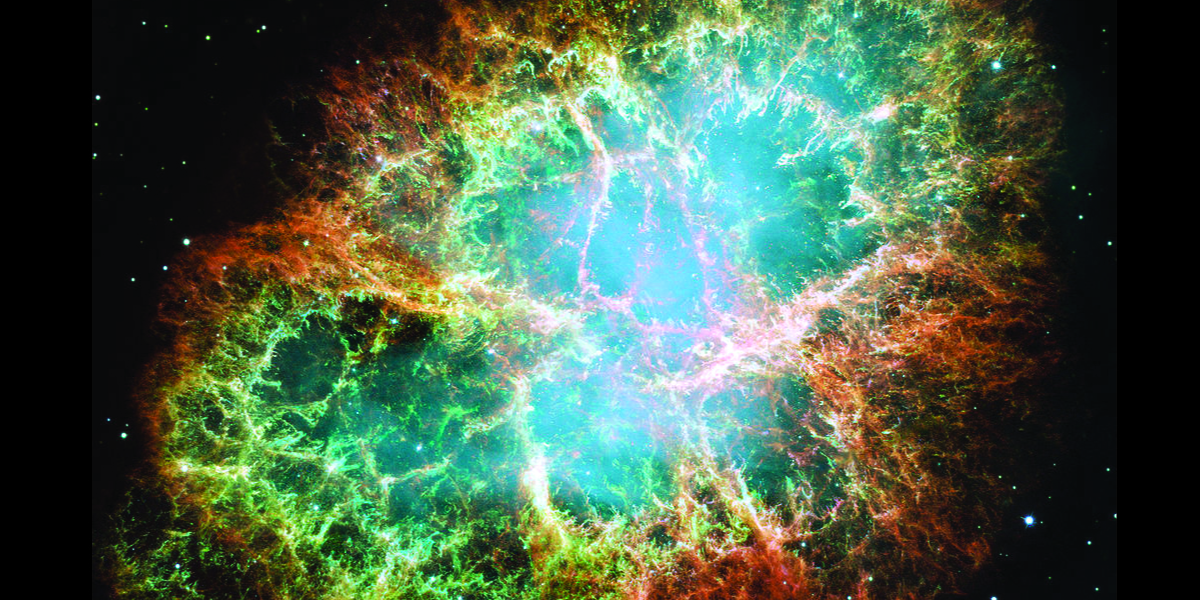Module 3: Chapter 3: Electronic Structure and Periodic Properties of Elements
Section outline
-
 The Crab Nebula consists of remnants of a supernova (the explosion of a star). By: Rice University Openstax CC BY NC SA
The Crab Nebula consists of remnants of a supernova (the explosion of a star). By: Rice University Openstax CC BY NC SAChapter Outline
3.1 Electromagnetic Energy3.2 The Bohr Model3.3 Development of Quantum Theory3.4 Electronic Structure of Atoms (Electron Configurations)3.5 Periodic Variations in Element Properties3.6 The Periodic Table3.7 Molecular and Ionic CompoundsUpon completion of this module, you will be able to:Electromagnetic Energy (3.1)- Explain the basic behavior of waves, including traveling waves and standing waves (CLO1)(CLO3)
- Describe the wave nature of light (CLO1)(CLO3)
- Use appropriate equations to calculate related light-wave properties (CLO2)
- Distinguish between line and continuous emission spectra (CLO1)
- Describe the particle nature of light (CLO1)(CLO3)
The Bohr Model (3.2)- Describe the Bohr model of the hydrogen atom (CLO1)
- Use the Rydberg equation to calculate energies of light emitted or absorbed by hydrogen atoms (CLO2)
Development of Quantum Theory (3.3)
- Extend the concept of wave–particle duality that was observed in electromagnetic radiation to matter as well (CLO1)
- Use probabilities to explain the quantum mechanical nature of electrons in an atom (CLO1)
- List and describe traits of the four quantum numbers that form the basis for completely specifying the state of an electron in an atom (CLO1)(CLO2)
Electronic Structure of Atoms (Electron Configurations) (3.4)
- Derive the predicted ground-state electron configurations of atoms (CLO2)
- Identify and explain exceptions to predicted electron configurations for atoms and ions (CLO2)
- Relate electron configurations to element classifications in the periodic table (CLO1)
Periodic Variations in Element Properties (3.5)
- Describe and explain the observed trends in atomic size, ionization energy, and electron affinity of the elements (CLO1)
The Periodic Table (3.6)
- State the periodic law and explain the organization of elements in the periodic table (CLO1)
- Predict the general properties of elements based on their location within the periodic table (CLO1)(CLO3)
- Identify metals, nonmetals, and metalloids by their properties and/or location on the periodic table (CLO1)(CLO3)
Molecular and Ionic Compounds (3.7)
- Define ionic and molecular (covalent) compounds (CLO1)
- Predict the type of compound formed from elements based on their location within the periodic table (CLO1)(CLO3)
- Determine formulas for simple ionic compounds (CLO1)
To achieve these objectives:
- Read and view the Module 3: Chapter 3: Electronic Structure and Periodic Properties of Elements in Moodle
- Read Chapter 3: Electronic Structure and Periodic Properties of Elements in the OpenStax Chemistry: Atoms First 2e Pressbook
- Complete the Module 3: Chapter 3: Electronic Structure & Periodic Properties of Elements Assignment
- Complete the Module 3: Chapter 3: Electronic Structure & Periodic Properties of Elements Discussion
- Complete the Module 3: Lab 3: Video (VWS) Assignment - Quantum_Numbers
- Complete the Module 3: Lab 3: Experiment - E&M_Quantum_Numbers
- Complete the Module 3: Lab 3: Report - E&M_Quantum_Numbers
Note the checkboxes to the right that help you track your progress: some are automatic, and some are manual.
Module Pressbooks Resources and Activities
You will find the following resources and activities in this module at the Pressbooks website. Click on the links below to access or complete each item.
Background Colour
Font Face
Font Kerning
Font Size
Image Visibility
Letter Spacing
Line Height
Link Highlight
Text Colour
